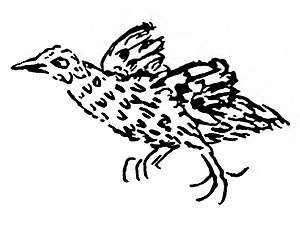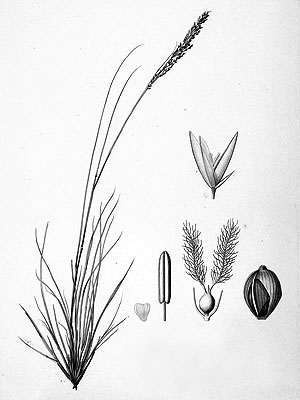Ascension Island Wood Fern (Dryopteris ascensionis)
The Ascension Island Wood Fern is very closely related to the two species Dryopteris cognata (C. Presl.) Kuntze und Dryopteris napoleonis (Bory) Kuntze, both of which are endemic to the island of Saint Helena.
The species grew only at the Green Mountain, the only place on Ascension Island, where a dense vegetation cover exists, and was found for the last time in the year 1889, and is since considered extinct.
The reason for this are introduced, invasive plant species, which overrun the native vegetation.
*********************
edited: 23.09.2017
Tag Archives: Ascension Island
Mundia elpenor (Olson)
Ascension Island Rail (Mundia elpenor)
The Ascension Island Rail was described in 1973 based on subfossil bones recovered from deposits on the desolate Ascension Island in the middle of the Atlantic Ocean.
The species, however, had already been described by a eyewitness, an observative traveller named Peter Mundy, in 1656.:
“Some of our company went up and broughtt downe six or seven goates, doubtlesse att first left there by the Portugalls: allsoe halfe a dozen of a strange kind of fowle, much bigger than our sterlings ore stares: collour gray or dappled, white and blacke feathers intermixed, eies red like rubies, wings imperfitt, such as wherewith they cannot raise themselves from the ground. They were taken running, in which they are exceeding swift, helping themselves a little with their wings … shortt billed, cloven footed, thatt can neither fly nor swymme. It was more than ordinary dainety meatt, relishing like a roasting pigge.” [1]
***
Ascension Island is a very dry place, and apparently always has been, without any typical rail habitats, no wetlands, no forests with dense undergrowth, nothing, thus, the rail is thought to have been an opertunistic omnivore that found its food amongst the large seabird colonies; it might have fed on seabird carcasses, eggs, and every kind of leftovers.
*********************
References:
[1] R. C. Tempe; L. M. Anstey (eds): The Travels of Peter Mundy in Europe and Asia, 1608-1667. Hakluyt Society SII 78(5): 1-226. 1936
[2] Storrs Olson: Evolution of the rails of the south Atlantic Islands (Aves: Rallidae). Smithsonian Contributions to Zoology 152: 1-53. 1973
*********************

(public domain)
*********************
edited: 07.02.2020
Nycticorax olsoni N. P. Ashmole, K. E. L. Simmons & W. R. P. Bourne
Ascension Island Night-Heron (Nycticorax olsoni)
This species of night-heron was described in the year 2003 based on subfossil bones, which were found in guano deposits. In live this species was somewhat smaller than the Night-Heron (Nycticorax nycticorax (L.)), and it was most probably a weak flyer but not fully flightless.
The Ascension Island Night-Heron may have stayed near the coast, where it searched the giant sea bird colonies, existing on the island at that time, for unattended fledglings, resp. fished for crustaceans at the shore.
The species reached a length of about 50 to 60 cm.
The circumstances of its extinction are not known, but introduced rats may well have played a role as they did in so many other cases of extinctions of birds on islands.
***
In chapter 21 (D’une isle nommée l’Ascention.) of his book ‘Les singularitez de la France antarctique, autrement nommée Amérique, et de plusieurs terres et isles découvertes de nostre tems.’ from the year 1557 André Thevet describes a bird from Ascension Island which indeed could well be the Ascension Island Night-Heron.:
“Dauantage en ceste isle s’en trouue une espece de grands, que i’ay ouy nommer Aponars. Ils ont petites ailes, pourquoy ne peuuent voler. Ils sont grands et gros comme noz herons, le ventre blanc, et le dos noir, comme charbon, le bec semblable à celuy d’un cormoran, ou autre corbeau. Quand on les tue ils criênt ainsi que porceaux.”
translation:
“Furthermore in this Ilande there is a certayne kinde of greate birdes that I have heard called Aponars, they have little wings, and therefore they cannot flye. They are great and hye lyke hearnshawes, the belly white, and the backe blacke as cole, the byll lyke to a cormorant, or a different crow. When they are killed they crye lyke hogs.” [1]
***
The Ascension Island Night-Heron very likely disappeared shortly after.
*********************
References:
[1] A. Thevet: The new found worlde, or Antarctike. London: Henrie Bynneman for Thomas Hacket 1568
*********************
edited: 20.10.2016
Sporobolus durus Brongn.
Ascension Island Dropseed Grass (Sporobolus durus)
The Ascension Island Dropseed Grass is one of the few native resp. endemic plant species of Ascension Island.
The species was last recorded in the year 1886 at the White Horse Hill, where it grew at an elevation of about 450 m. This place is now densely covered with the introduced Molasses Grass (Melinis minutiflora P. Beauv.).
The Ascension Island Dropseed Grass could not be relocated during extensive searches in the year 1998, and it is now considered extinct.
*********************

(public domain)
*********************
edited: 18.05.2011
